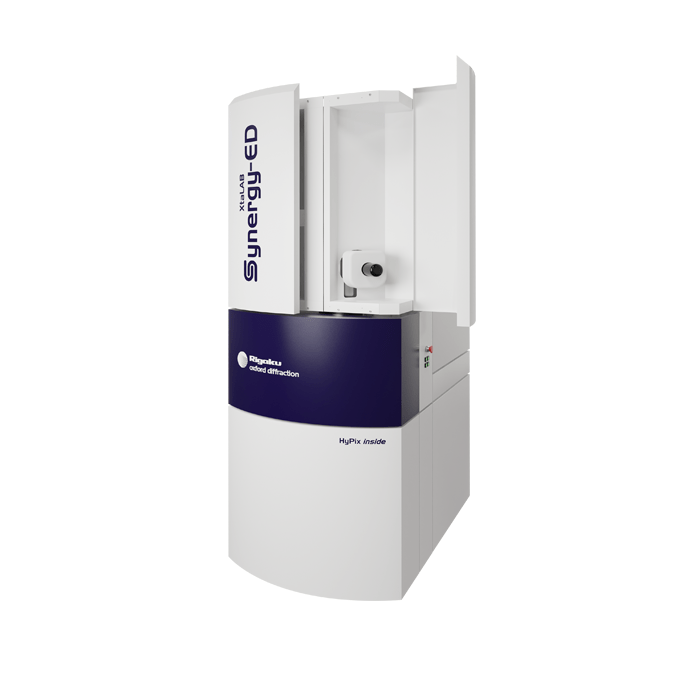Rigaku Corporation, a leading company producing X-ray analysis instruments, and JEOL Ltd. (Headquarters: Akishima, Tokyo, Japan; President & COO: Izumi Oi), a leading company producing electron microscopes and other analytical instruments, have announced the launch of the XtaLAB Synergy-ED, an integrated electron diffraction platform for the determination of molecular structures from nanocrystals, a joint project that has been underway since May 2020.

XtaLAB Synergy-ED is a new and fully integrated electron diffractometer, creating a seamless workflow from data collection to structure determination of three-dimensional molecular structures. The XtaLAB Synergy-ED is the result of an innovative collaboration to synergistically combine our core technologies: Rigaku’s high-speed, high-sensitivity photon-counting detector (HyPix-ED) and state-of-the-art instrument control and single crystal analysis software platform (CrysAlisPro for ED), and JEOL’s long-term expertise and market leadership in designing and producing transmission electron microscopes. The key feature of this product is that it provides researchers an integrated platform enabling easy access to electron crystallography. The XtaLAB Synergy-ED is a system any X-ray crystallographer will find intuitive to operate without having to become an expert in electron microscopy.
The determination of 3D molecular structures at the atomic level is a key technique for driving innovation in the drug discovery, synthetic chemistry and material science fields. Single crystal X-ray structure analysis has long been the primary technique used to determine accurate 3D molecular structures for inorganic, organic and protein molecules. By providing highly accurate and reliable molecular structures, X-ray crystallography has contributed to the discovery of new substances, elucidation of biological activity and chemical reactivity, prediction of interactions with other substances, and confirmation of expected efficacy of medicines.
However, in recent years, there has been an increasing need for the structure analysis of substances that only form microcrystals, crystals that are only a few hundred nanometers or less in size. Analysis of crystals of this size is not possible with X-ray crystallography, where the smallest possible crystal dimension is 1 micron, and only then when utilizing the brightest X-ray sources. In recent years, a new analytical method, MicroED, has been developed that uses electron diffraction on a TEM electron microscope to measure 3D molecular structures from nanocrystalline materials. Researchers developing this technique have relied on customized electron microscopes and a combination of microscopy software for measuring diffraction data, and public domain X-ray crystallography software for data processing and structure determination. Switching a microscope configuration between imaging and diffraction can be time-consuming, making the sharing of an instrument sometimes difficult.

Gefitinib (crystal size is about 300nm)
To address these issues, Rigaku and JEOL started a collaboration to develop a dedicated single crystal structure analysis platform for nanocrystals utilizing key technologies from both companies. The result of this collaboration is the XtaLAB Synergy-ED, a dedicated electron diffractometer that is operated by the same control software that is used to run Rigaku’s X-ray diffractometers and includes a complete integrated pipeline from sample selection and diffraction measurement to data processing and structure solution. This instrument can easily be installed in an existing X-ray crystallography facility, where researchers and students will be able to easily master the MicroED technique since the software workflow is the same as for an X-ray diffractometer. Having such an instrument installed in an X-ray facility immediately provides structure determination for materials that only form nanocrystals.
Today, on the first anniversary of signing the joint development agreement with JEOL, we are very pleased to see the collaboration between the two companies has come to fruition and we are launching the XtaLAB Synergy-ED. Rigaku will steadily follow our corporate philosophy of “contributing to the development of human society through advances in science and technology,” and will continue to provide solutions satisfying our customers.
Hikaru Shimura, Chairman & CEO of Rigaku Corporation
We are proud that the collaboration between Rigaku and JEOL has created a synergistic effect among the core technologies of both companies and reached the point to announce the new platform XtaLAB Synergy-ED. Since its foundation, JEOL’s main goal has continued to be “contributing to the progress in both Science and Human Society” on the basis of “Creativity” and “Research & Development”. As progress in science and technology has been remarkable and the roles expected from a company are diversifying, we will continue to provide solutions matching the needs enabling customer innovation.
Izumi Oi, President & COO of JEOL Ltd.
